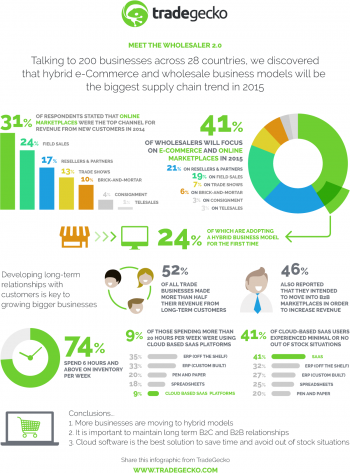E-Commerce Drives A New Generation of Wholesalers

Wholesalers are harnessing the power of the Internet, and experts say adopting hybrid models, with a focus on e-commerce and online marketplaces, will be the biggest supply chain trend the year.
Selling online, both through e-commerce platforms and online B2B marketplaces, is a top priority for wholesalers, according to a new survey.
The potential for revenue growth is huge. The value of the B2B e-commerce market is expected to dwarf that of the B2C market by the end of the decade. Research from Frost & Sullivan projects the gross value of merchandise sold through B2B e-commerce channels to top $6.7 trillion by 2020, two times the expected value of the consumer marketplace in the same period.
Online platforms are also bringing wholesalers new customers. The 200 wholesalers across the globe surveyed by TradeGecko said online marketplaces were the top drivers for new customers in 2014, generating more new business than the traditional B2B sales methods of field sales, and resellers and partners. The opportunity to capture new customers will continue to grow as more and more procurement teams are turning to the Internet, both to research and complete purchasing decisions.
New customers for digital suppliers is a reflection of increased online procurement spending: 68 percent of B2B buyers made online purchases last year, a more than 10 percent increase over 2013, TradeGecko found. Additional research from Acquity Group found nearly half of businesses spent at least half of their procurement budgets online in 2014, with 46 percent planning to increase the amount spent in 2015.
New customers may drive growth, but long-term customers drive revenue for the majority of businesses surveyed by TradeGecko. More than half (52 percent) of wholesalers reported more than half of their revenue came from long-term customers.
Maximizing the online experience, industry experts say, will attract new business and keep existing customers happy. Buyers, even at the wholesale level, expect the feel they have become accustomed to as shoppers in their personal lives. Buyers have no problem finding a new wholesaler if the e-commerce experience fails to meet their needs and expectations. Nearly 70 percent of B2B online shoppers abandoned a cart in the past 12 months, according to the Acquity Group.
Wholesalers can limit cart abandonment by focusing on the ordering experience. Buyers are increasingly independent and want to be able to complete the purchasing processes with minimal sales support. More than half of procurement officers interviewed cited convenience and ease of use as two ways wholesalers could encourage more online spending. E-commerce sites should be well designed and product pages should contain all of the necessary information to make a purchasing decision. Sellers can also differentiate themselves by offering additional post-sale services. Top requests include invoice printing, warranty tracking and the ability to have a secure profile to record spending.
After price and customer service, the research found that online buyers prioritize speed of delivery. Proper inventory management is one way wholesalers can address order turnaround.
Low- or out-of-stock situations can easily drive customers to competitors, but wholesalers surveyed by TradeGecko spend a lot of time on inventory management without getting much in return. Nearly three-quarters spend more than six hours a week on inventory-related activities. Businesses still relying on pen-and-paper or manual data-entry for inventory may spend up to 20 hours a week. More than being time consuming, inventory management adds one more system to companies that are already struggling to effectively integrate multiple systems. Working across various systems increases the risk of human error and limits access to historical sales and inventory records for forecasting. Wholesalers surveyed by TradeGecko found that moving to cloud-based software dramatically reduces the amount of time spent on managing inventory and inventory shortages, which, in turn, reduces the chance for error.
The modern wholesaler isn’t about just using e-commerce and online marketplaces to create new business, TradeGecko concludes. Thoughtfully addressing buyer expectation and considering tools to ease reporting and inventory management add value that makes the supply chain smarter.
